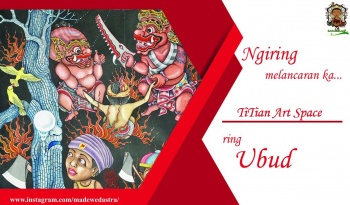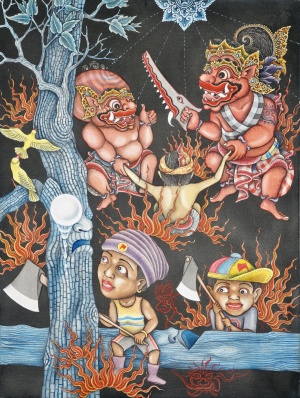- Name of Place
- TiTian Art Space
- Location
- Reference
- http://www.titianartspace.com/
- Lontar
- Folktales
- Biographies
- Children's Books
- Books
- Holidays and Ceremonies
Information about place
In English
Batuan artist I Made Sujendra explains the work with the simple question: “how does it feel to be a tree?” In the background two ogres with prison tattoos hold a small human figure’s arms outstretched with a wood saw poised to lop them off. This is one of nine acrylic paintings in Sujendra’s first solo exhibition at Ubud’s TiTian Art Space, each showing scenes of sin and punishment like 15th Century Dutch painter Hieronymus Bosch’s visions of hell. However the artist says he is not familiar with the Bosch. Instead, his inspiration comes from the hundreds of small paintings on the ceiling of Bali’s former supreme court building, the Kerta Ghosa. This long and ornate open-sided shed on the former Royal Palace grounds at Klungkung was the final court of appeal in pre-colonial Bali. Evidence was not given under oath, but after the judgement either plaintif or accused would be required to give the “oath of truth”. Depending on the seriousness of the crime, the liar would face greater or lesser karmic penalties. While the judges sat at their tables and heard evidence, both plaintif and accused sat on the floor where they would gaze at hundreds of small paintings showing scenes of misfortune and torture, each being a penalty for perjury. In severe cases you and your family would spend several lifetimes working off this karma. As a legal system, it worked so well the Dutch kept it in place and it survived until Indonesian courts came to Bali with the modern Republic. Sujendra says the painting was prompted by people destroying a tree wantonly, not for building or carving, and without planting and carefully nurturing a new tree in its place. He had not considered, for example, slash and burn agriculture to establish palm oil plantations in the forests of Sumatra and Kalimantan. Sujendra is an intensely Balinese artist with Balinese concerns. His style is also largely Balinese in scope, although not in the same traditional Kamisan style of the Kerta Ghosa paintings. Kamisan was a graphic style already well-developed in the 19th Century, based on Wayang Kulit puppets. Sujendra did not grow up studying this style, but the more modern and secular Batuan style he learned from his father. Typical Batuan paintings have myriad brightly-coloured figures on a black background, and leave the eye to wander from figure to figure with no clear centre of interest. Without departing from this formula, Sujendra has simplified and intensified the effect of the Batuan style by showing fewer figures on a much larger canvas and returning to religious themes. Two of the paintings in this show are black and white.
You can see Sujendra’s paintings for a few more days if you are in Ubud, before the exhibition closes on January 20. Staff and members will then prepare to celebrate TiTian’s third anniversary on January 31.In Balinese
Lukisan
Seniman Batuan
Lukisan-lukisan khas Batuan
In Indonesian
Sujendra mengatakan lukisan itu dipicu oleh orang-orang yang menghancurkan pohon secara sembarang. Tujuannya bukan untuk membangun atau memahat serta tanpa menanam kembali ataupun memelihara tunas baru. Semisal, memotong dan membakar sawah, ladang, dan hutan untuk kepentingan perkebunan kelapa sawit di hutan Sumatra dan Kalimantan. Alam semakin rusak, pohon mulai langka.
Seniman Batuan I Made Sujendra menuangkan semuanya dalam lukisannya. Ini sebagai bentuk kepeduliannya terhadap alam Bali. Gayanya juga sebagian besar dalam lingkup Bali, meskipun tidak dalam gaya tradisional daerah Kamasan yang sama dari lukisan Kerta Ghosa yag terkenal, Sujendra penganut gaya Batuan yang lebih modern dan sekuler yang ia pelajari dari ayahnya.
Lukisan-lukisan khas Batuan memiliki banyak sekali tokoh-tokoh berwarna cerah dengan latar belakang hitam, dan membiarkan mata untuk mengembara dari sosok ke sosok tanpa pusat perhatian yang jelas. Tanpa menyimpang dari formula ini, Sujendra telah menyederhanakan dan mengintensifkan efek gaya Batuan dengan menunjukkan lebih sedikit tokoh di atas kanvas yang jauh lebih besar dan kembali ke tema-tema keagamaan.
Geoff Vivian








Enable comment auto-refresher